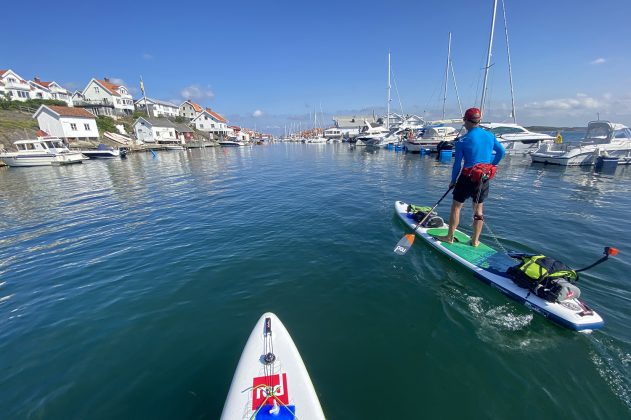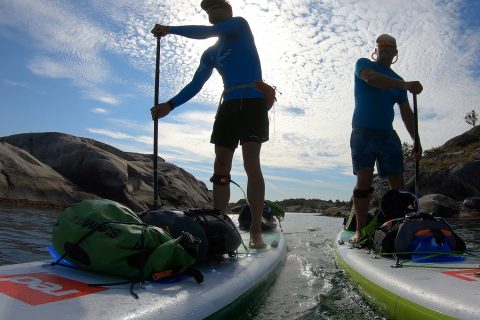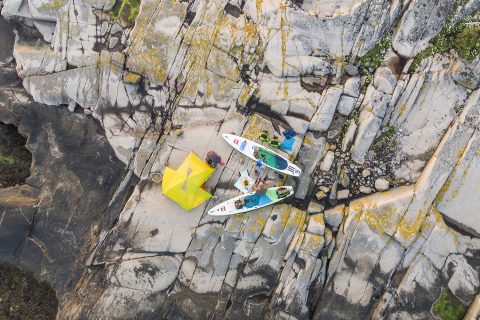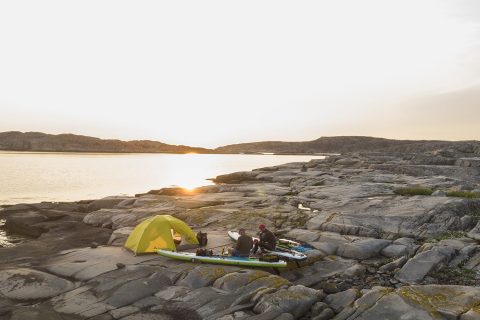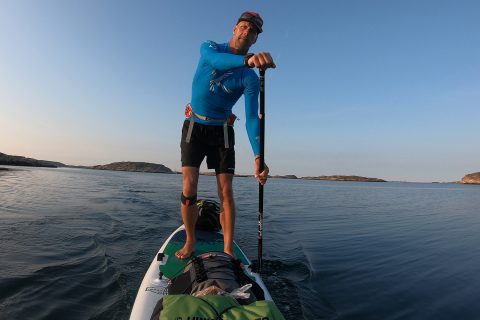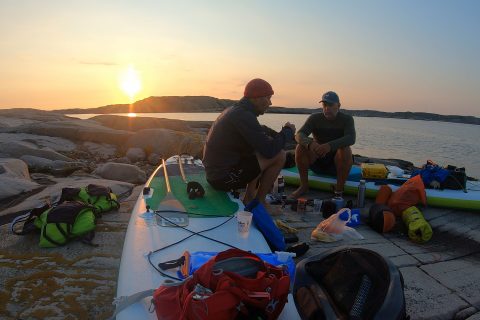From our Autumn edition of SUP International magazine, Swedish paddlers Göran Gustavsson and James Venimore give their advice on how to approach long-distance paddling, as they take on a huge 140km mission from Tjörn to Strömstad along the west coast of Sweden.
WORDS James Venimore // PHOTOS Kajaktiv.se
After their initial plans to paddle across the open water to Åland and continue onto Finland this summer were crushed by the issue of the border being closed. Not to be put off, Göran and James decided to make the most out of the training and went paddling on the northern half of the Swedish west coast. Here are their tips they learned from the experience:
Weather: This is no doubt the most critical element to take in, paddling a SUP into head wind for a day or more is very taxing, so it’s best to have a flexible plan or to go with the wind, so you have predominantly tail winds all the way. Use of various websites will give you both the long-term forecasts and even trends for the wind direction for that time of year.
- Paddle mission!
Have a plan B: To have a plan B on the days it will be tough to paddle with head winds and strong side winds is one idea, this can be to paddle on the lee side of some islands, or to take a day off and just explore the area.
Choose your board wisely: The choice of board is possibly the next consideration, to paddle an entry level 10-foot board with a pressure of 15-20 PSI is going to make very slow progress. You are really going to want a longer board of 12 to 14 feet in length that is stiff, this is going to give the speed you need to be effective. The width of around 30 inches, is going to mean you can also handle side waves better when it comes to stability. On this journey we used two Red Paddle Co Voyager 13’2 x 30 touring boards that are very stiff and robust with lots of tie down points.
Inflatable or hard board? Our preference is a top-quality inflatable, the speed difference is marginal when touring, and they can be more stable in rough conditions, plus you can hit rocks and not need to take the same care of them as a glass board. Another bonus is you can roll them up and take them on the train back to where you started. The train station was just 100 m from where we got out and we took the train back to Stenungsund. Saving a shuttle drive of 4 hours.
- Self sufficient!
Packing: We have seen others doing long trips on for example the Yukon river and the like, and the most just strap down large drybags on the board, but this makes them really ineffective when paddling into the wind or worse with side winds. So, we looked for a low-profile solution, and the Redpaddle deck bags suited us perfectly. We used two each, four in total. Into them we easily packed the following items.• Lightweight self-standing 2 persons Macpac Duolight tent.
• 2 x 400 g Macpac down sleeping bags.
• 2 x Exped lightweight inflatable sleeping mats.
• 10 REAL dry food meals.
• 2 x 300g packets of Muesli.
• Primus Lite Stove and a large gas canister
• Extra small Primus metal pot.
• Clothing and personal items.
• Mavic Air Drone and 4 batteries.
- Escape from reality
On the outside the pockets allowed for:
• Insulated 750 ml bottle.
• Sunscreen and insect repellent.
• Place to hold the map.
We also strapped a 4 litre Source liquitainer for water to the board and Göran put a pair of running shoes in a dry bag on top.James carried a single barrel high pressure pump that was never needed. Göran took a spare 5-piece paddle as a reserve (also not needed but good to have), both had adjustable Redpaddle Carbon racing paddles. You can adjust the paddle length during the day to make a change, which helps on a long day. Our longest day was 45 km from outside Lysekil to past Hamburgersund through Sötenäs canal.The use of the Red Original deck bags kept our profile low and also easy to keep things organised and packed quickly. They were fixed with both bungees on the board and lines from the bag. We noticed when we lifted them out of the water on the whole it was lighter and easier than a kayak making it possible to lift the board loaded to our prime campsite for the night in one go.Navigation. We used the Calazo 1.50 000 maps for the west coast, these are excellent showing detail such as boat routes, ‘topographic’ information and all you need to navigate by reading the landscape. We also had a deck compass from Silva, this helped in the fog, although we regretted not taking the GPS. But our phones were helpful as there is 4g network the majority of the coastline, also making it good to keep an eye on changing weather conditions.
- Cruising in Sweden!
10 tips for long distance paddling:
• If the weather is good, make the most of it, get up and paddle early before it gets warm, then you can take a long lunch during the hottest part of the day.• Make the most of the small harbours, cafe and restaurants along the way. Save the dry food for dinner when your most likely tired. Take your favourite energy bars, and good coffee!
• Have drinking discipline while paddling, stop and drink every 30 minutes, even when it’s not hot, having water around you fools you to feel not so thirsty, leading to being tired quicker, headaches and dehydration in general. Refill in the small guest harbours you pass.
• Go simple and light, we had just one change other than our paddling wear plus a thermal top and rain jacket, neither were needed.
• Pack all clothing and sleeping bags etc in a thin drybag inside a good waterproof deck bag. You can then also compress them to a smaller size.
• Stay visible to boat traffic, wear bright colours, and if you’re unsure about a boat coming in your direction wave your paddle.
• Train seriously if you’re planning a large open water crossing or long tour, it will make it safer and a lot more enjoyable.
• Lifejacket for larger open water crossings, and a board leash as always is mandatory. We had Hiko Stamina lifejackets we wore only on the open water sections like we did over to Kärringön, these also have a 1.5 litre drinking bladder.
• Carry more than one form of emergency communication each, this can be your telephone in a waterproof case, Nödsändare (we used a SPOT X and SPOT gen3), smoke or and rocket flares, whistle and tell someone your plans.
• Have a plan B, for example on our plans to Finland we knew if the wind/weather changed for the worse we needed to find a way home within the end of the week, so we checked boat ferries from a different island into Mariestad or Åbu from where we can easily get home.
- Camping out!
Advantages to paddling a stand up board compared to a Sea kayak.
• Easy to transport on public transport to and from a new area.
• Better vista from the view of the paddler when you stand up.
• You can take a swim when you want with ease.
• Great physical training for the whole body.
Disadvantages• Not as effective paddling into the wind.
• Limited space for camping equipment.
• More exposed to the elements.
• Less chocolate and beer at camp.
Summary: Long distance on a SUP is not going to compete or replace Sea Kayaking, it’s simply another form of exploring the lakes, rivers and oceans from another perspective. It definitely is harder work, but at the same time very rewarding. Possibly the biggest advantage is the ability to roll up the board and take it on a train or bus back to your car if not all the way home.
Footnote: James and Göran paddled 140 km over 4 days with good winds, and hope to make the crossing to Finland unsupported 2021.

